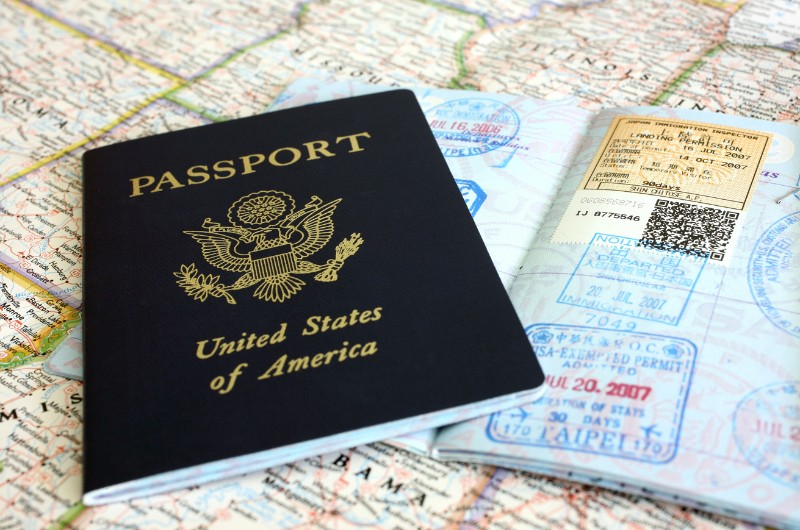Packing your bags for a Cambodian adventure? Buckle up because you’re in for a wild ride filled with breathtaking views, mouthwatering food, and the warmest smiles! As you start preparing, a million questions pop up — What are the entry requirements for Cambodia? When’s the best time to explore the sun-kissed temples? Is it easy to get around? And, of course, what delicious dishes should be on my must-try list?
Fear not! This Cambodia Travel Guide is here to be your ultimate sidekick, shining a light on all the essentials to make your trip smooth and unforgettable. Let's start!
Cambodia Entry Requirements
First up, you’ll need a passport with at least six months’ validity from your entry date.
To enter Cambodia, most travelers will need a visa, but don’t worry — it’s easy (really easy)!
You can grab a Visa on Arrival for about $30 USD at main airports like Phnom Penh and Siem Reap or at specific land borders, allowing you a 30-day stay. If you’d rather skip the queue, the Cambodia e-Visa option lets you apply online for $36, typically processed in 3-5 business days. Some lucky travelers from Southeast Asian countries, including Laos, Malaysia, and Singapore, can even enter visa-free for up to 30 days!
A heads up: you’ll need USD cash for the visa fee, so pack small bills, especially if you’re entering overland, where card payment might not be possible.
Some travelers report being asked for proof of onward travel, especially at airports. This isn’t strictly enforced, but to be on the safe side, have a return or onward ticket ready.
Lastly, while it’s not an entry requirement, having travel insurance is a smart move when visiting Cambodia — or any foreign country, really! This ensures you’re covered for any unexpected medical expenses, lost belongings, or other surprises during your adventure. Please keep in mind that the rules and regulations might change from time to time, so always check for updates before planning your trip.
What’s the weather like in Cambodia?
Cambodia’s climate is a warm, tropical paradise all year. The weather here breaks down into two main seasons: the dry season (November to April) and the green season (May to October).
- Dry Season (November to April): This is the most popular travel period, with low humidity, sunny skies, and ideal temperatures for temple-hopping. The weather is comfortably warm, ranging between 25°C and 35°C (77°F to 95°F). December through February tends to be the coolest and most comfortable, while March and April can be a bit hotter.
- Green Season (May to October): This is when Cambodia shows off its lush side! Afternoon showers are common but brief, leaving plenty of time to explore. The rain brings out the vibrancy in Cambodia’s landscapes, making places like Angkor Wat especially photogenic against dramatic clouds and greenery. You’ll enjoy cooler temperatures (around 24°C to 32°C or 75°F to 90°F) and the bonus of fewer travelers and lower travel costs. Don’t worry too much about rain — just bring a light rain jacket, and you’re all set!
Read more on Green Season Travel: Top 5 Myths About Southeast Asia’s Rainy Season.

Is Cambodia a safe country to visit?
You bet! Cambodia is generally a safe spot for travelers, and you’ll be greeted with smiles and warmth from the locals everywhere you go. While exploring the lively streets of Phnom Penh or the charming alleys of Siem Reap, it’s a good idea to keep an eye on your belongings, especially in crowded markets—just a little common sense goes a long way!
And if you’re into biking, you’re in for a treat! The country’s working on becoming more cyclist-friendly, especially around Siem Reap. It’s an adventurous way to see the breathtaking landscapes, and you’ll find locals willing to point you in the right direction if you need it.
Sure, like any destination, it’s smart to avoid walking alone in quieter areas at night and stick with reputable transportation options. But overall, Cambodia’s laid-back vibe and friendly folks make it a great place to explore.
Roam with confidence on our guided bike tours through Cambodia! With manageable riding distances, a mix of fun activities, and plenty of downtime, these tours are designed for everyone.

Money and currency in Cambodia
When visiting any new country, understanding the local currency, its cash and card culture, can make your stay much smoother. Here's what you need to know about managing money in Cambodia:
Official Currency of Cambodia
The official currency of Cambodia is the Cambodian Riel (KHR), but you’ll see US dollars (USD) everywhere! While the dollar is widely accepted, there’s a catch: Cambodia is working on phasing out the dollar, so many places are reluctant to accept smaller bills. Plus, if a dollar bill has even a tiny rip or looks too worn, you might run into issues. So if carrying USD it’s best to make sure your cash in good shape.
The Riel is typically accepted without the same fuss. You’ll also find cash exchange shops in abundance in main cities like Phnom Penh and Siem Reap, making it easy to get your hands on local currency.
ATM’s in Cambodia
You’ll find plenty of ATMs in Cambodia, especially in cities like Phnom Penh and Siem Reap. Most of these machines accept international cards, so keep an eye out for those that display the Visa, MasterCard, or Cirrus logos. Just a heads-up: many ATMs have withdrawal limits, typically around $200–$300 per transaction, and might charge a fee for foreign cards, so be sure to check before you hit “withdraw.”

Using Credit Cards in Cambodia
Credit cards are becoming more popular in Cambodia, especially in popular hotels, restaurants, and shops in touristy areas. Visa and MasterCard are the most widely accepted, but smaller local businesses and markets don’t have the facilities to accept cards and often prefer cash. So, if you’re planning to explore those hidden gems or grab a bite from street vendors, it’s smart to keep some cash handy!
Cash in Cambodia
While digital payments are on the rise, cash is still king in Cambodia, particularly in rural areas. You’ll definitely want cash for night markets, local shops, and when hopping in a tuk-tuk (some drivers accept cards, but don’t count on it). It’s always a good idea to have small bills as many vendors might struggle to give you change for larger notes.
Quick Money Tips for First-Timers
- Inform Your Bank: Let your bank know about your travel plans to avoid any hiccups with card usage abroad.
- Check Exchange Rates: Familiarize yourself with the latest exchange rates to avoid confusion when making purchases.
- Exchange Some Cash Ahead of Time: While ATMs are widely available, having some local currency on hand when you arrive is useful for those immediate small purchases or potential emergencies (lost luggage anyone).
- Keep Small Change for Small Vendors: Try to carry smaller notes and coins for street vendors and taxis who might not have enough change to spare.

Should you tip in Cambodia?
When it comes to tipping in Cambodia, it’s a bit like adding that extra chili sauce to your noodle dish — entirely up to you, but it sure makes things more enjoyable! While tipping isn't mandatory, it’s appreciated, especially in the service industry. In restaurants, rounding up the bill or leaving a dollar or two is a nice gesture, particularly if you received good service. For guides and drivers, a tip of around $5-10 for a full day of service is a great way to say thanks for showing you around the wonders of Cambodia.
Note: If you jump into one of our Grasshopper Adventure tours in Cambodia, you’ll be happy to know that tips for dining and service folks are all sorted out. That means you can dive into the delicious local food and soak up the culture while keeping your wallet in your pocket—no tip math required!

How to Get Around in Cambodia?
When it comes to getting around Cambodia, you’ve got options galore! Whether you're hopping from city to city or exploring the scenic countryside, here’s how to do it:
Buses: For budget travelers, buses are the way to go! They’re super affordable and connect major cities like Phnom Penh, Siem Reap, and Battambang. Companies like Giant Ibis and Mekong
Express offer comfy rides with air conditioning and even Wi-Fi on some routes.
Taxis, Rideshare Apps, and More: Need a lift? Grab (app) is your best buddy here! This app is widely used in Cambodia and surrounding countries, letting you easily book taxis, tuk-tuks, and remorks (a traditional Cambodian motorcycle taxi) without the hassle of haggling. Think of it as the Uber of Southeast Asia.
But if you're feeling a bit adventurous, you can always opt for a traditional taxi or snag a tuk-tuk on the street and negotiate the fare yourself. Just make sure to negotiate the price beforehand to avoid any unexpected surprises!
Domestic Flights: If you’re looking to cover some distance quickly, consider domestic flights. Airlines like Cambodia Angkor Air and Sky Angkor offer short hops between popular destinations, so you can maximize your adventure without spending hours on the road.
Cycling: And of course, our absolute favorite way to explore — on two wheels! Cycling through Cambodia is an unforgettable experience. With its mix of laid-back urban landscapes, serene countryside, and stunning temples, the scenery is just begging to be explored at a leisurely pace. Plus, it's a fantastic way to connect with locals and discover hidden gems along the way!
Read more on 3 Ways to Visit Angkor Wat by Bike.
Check out this video, made in collaboration with local businesses, on what you can experience on your visit to Siem Reap, Cambodia, and find out what our Cambodia bike tours are all about!
What to Do in Cambodia
Cambodia’s got you covered with a wild mix of history, culture, and breathtaking landscapes! Here are five epic things you absolutely can't miss:
- Grab a bike and hit the trails around Angkor Wat! You’ll be cruising past ancient temples and lush jungles, soaking in the vibes of this iconic spot. Pro tip: the sunrise views are nothing short of jaw-dropping!
- Climb aboard a boat and glide through the floating villages on Tonle Sap Lake, where life flows with the rhythm of the water. This unique community is home to families who have adapted to life on the lake
- Paddle alongside freshwater dolphins in Kratie
- Make your way to Battambang for a taste of the real Cambodia. Jump on a bamboo train, explore the stunning countryside, and chat with locals who are always down to share their stories and smiles.
- Lace up your hiking boots and hit the trails in the Kulen Mountain Range. Known as the birthplace of the Khmer Empire, this stunning area is rich in history and natural beauty!
Inspired? Check out our guided bike tours through Cambodia.

Cambodia Food and Drinks
Forget boring meals — Cambodian cuisine packs a punch with a variety of tastes, from sweet and savory to umami and tangy. Each dish is an adventure for your taste buds, giving you a real feel for the country’s vibrant culinary heritage.
Top 5 Cambodian Dishes You Have to Try:
1. Amok Trey (Fish Amok): Dive into this beloved Cambodian dish, a creamy and fragrant fish curry steamed in banana leaves. Made with fresh fish, coconut milk, and a blend of aromatic spices, it’s a must-try! The flavors are rich yet delicate, often served with rice for a satisfying meal.
2. Lok Lak: This beef dish is a Cambodian classic. Tender strips of marinated beef are quickly cooked and served on a bed of fresh greens with tomatoes, cucumbers, and a side of rice. It’s typically accompanied by a tangy dipping sauce made from lime juice, salt, and pepper, adding a zesty kick!

3. Nom Banh Chok (Khmer Noodles): Start your day with this popular breakfast dish! These rice noodles are topped with a refreshing fish gravy, herbs, and crunchy vegetables. It’s light, flavorful, and perfect for fueling up before a day of exploring.
4. Sugarcane Juice: When you’re wandering the bustling streets of Cambodia, keep an eye out for vendors selling fresh sugarcane juice! This refreshing drink is made by pressing sugarcane stalks to extract the sweet, revitalizing liquid. Served over ice, it’s the perfect thirst-quencher on a hot da
5. Nom Pleai Ai (Sweet Coconut Dumplings): Don't miss out on this dessert! Made from rice flour dumplings filled with sweet palm sugar and topped with grated coconut. Served in a luscious coconut cream sauce, this treat is a favorite among locals and visitors alike, making it the perfect sweet ending to your Cambodian adventure!

Is vegetarian food available in Cambodia?
Oh, you bet! While traditional dishes often showcase meat and fish, you’ll discover a delightful array of veggie-friendly options, especially in cities and popular tourist spots. Street vendors serve up fresh vegetable dishes, zesty salads, and warming soups that burst with flavor.
Many restaurants even put their own twist on classic dishes like Amok, swapping out the meat for tofu or a rainbow of fresh veggies.

What to pack for Cambodia
With Cambodia’s tropical climate, you’ll want to pack lightweight, breathable fabrics, especially during the hot summer months. If you’re heading into the hills or visiting during the cooler season, don’t forget to pack a light jacket for the cooler evenings.
For Men: In Cambodia's vibrant cities and tourist hotspots, shorts and T-shirts are the way to go! While you can rock a casual tank top, it’s often better to stick with short sleeves to fit in comfortably. If you're planning to visit temples or participate in any formal events, remember to cover up with light pair of long pants and a nice shirt to show respect.
For Women: Ladies, you’ll find a mix of Western and local styles in Cambodia. Skirts, dresses, and shorts are common, but modesty is key, especially in rural areas and sacred sites. A shawl or scarf can be a lifesaver for covering up when needed, and good protection from the sun!
Religious and Cultural Sites: Cambodia is home to stunning temples like Angkor Wat, so be sure to wear clothing that covers your shoulders and knees.
Electrical Sockets: Cambodia uses Type C and Type G electrical outlets (230V), so if you’re coming from a place with different plugs or voltages, don’t forget to bring a universal travel adapter. You’ll want to keep your devices powered up for all those epic photos!

Sun Protection: The Cambodian sun can be intense, so stock up on sunscreen, sunglasses, protective sleeves, and a wide-brimmed hat.
Insect Protection: Mosquito repellent is essential for enjoying those beautiful outdoor adventures without the itch! Bring along some after-bite cream for any pesky encounters.
Health and Safety: A small first aid kit is a good idea—think band-aids, antiseptic cream, and any prescribed medications. Being prepared means you can focus on all the amazing experiences ahead!
Finally, tailor your packing list to the adventures you’re excited for in Cambodia. Whether you’re exploring ancient temples, cruising the rivers, or immersing yourself in local culture, a little prep goes a long way!
And if you're joining us on a Grasshopper Adventure tour, we’ve got your back. We’ll provide you with a detailed, customized packing list to make sure you’re all set for an epic journey through Cambodia!

Internet in Cambodia
Wi-Fi is widely available in Cambodia, especially in tourist areas, hotels, cafes, and restaurants. Most places cater to travelers and offer free Wi-Fi, so you can easily share your incredible experiences online or plan your next stop without missing a beat. Just keep in mind that the quality and speed can vary, particularly in more remote areas.
For those times when Wi-Fi isn’t an option, grabbing a local SIM card is a smart move! You can find them easily at airports, convenience stores, or mobile shops in cities. Providers like Cellcard and Smart offer affordable data plans that will keep you connected on the go. Make sure your phone is unlocked to use a local SIM!
While Cambodia's internet speeds have improved in recent years, they might not be as fast as what you're used to back home. Streaming services may buffer, and downloads can take a little longer. But don’t let that stop you from enjoying the local sights and sounds!
To make the most of your trip, consider downloading maps and travel guides before you leave your accommodation. Apps like Google Maps and offline travel guides can help you navigate without relying solely on internet access.

Culture and Etiquette in Cambodia
Getting to know the local customs in Cambodia not only makes your travels more enjoyable but also helps you connect with the incredibly warm-hearted people you'll meet along the way. So, let’s dive into some handy dos and don'ts to keep your experience respectful and memorable!
DO'S
- Do show respect for monks. Approach them with reverence, and if you’re a woman, avoid physical contact. Always use both hands when giving or receiving anything and pass by quietly and respectfully to honor their presence.
- Do tell Cambodians how much you love their country! The locals are bursting with pride for their rich history and culture, so don’t hold back when chatting with them. Whether you’re raving about the breathtaking temples, mouthwatering food, or the warm hospitality, your enthusiasm will make their day.
- Smile and greet with a ‘Sampeah’. A friendly smile goes a long way in Cambodia, so flash those pearly whites! When you greet someone, try the traditional ‘Sampeah’—that’s palms together and a slight bow. The higher you raise those hands, the more respect you show.
Read more on How to Greet in 11 Asian Countries.
DON'TS
- Don't lose face in public! Keep things cool and respectful — fighting, arguing, or shouting is a no-go.
- Don’t display public affection. Save romantic gestures for private settings, as public displays of affection can raise eyebrows and are generally frowned upon.
- Don't point with your fingers! Instead, use an open palm when gesturing, as pointing can be seen as disrespectful.

Religion in Cambodia
Buddhism is the beating heart of Cambodia, with around 95% of the population identifying as Theravada Buddhists. This ancient tradition has been woven into the very fabric of Cambodian life, influencing everything from art and architecture to festivals and everyday practices. Picture saffron-robed monks strolling through bustling markets, their calm demeanor radiating serenity amidst the hustle and bustle.
In the spirit of community and compassion, temples (or wats) serve as social hubs, where locals gather for prayer, meditation, and community events. If you’re lucky enough to participate in a local ceremony, you’ll witness firsthand the beautiful rituals that bring people together—think incense, chanting, and offerings of fruit and flowers.
Cambodia's religious landscape isn’t just about Buddhism; it also boasts fascinating influences from Hinduism and animism. Many of the ancient temples, like the magnificent Angkor Wat, were originally built as Hindu shrines. The intricate carvings and sculptures reflect stories from Hindu mythology, showcasing the artistry and devotion of the time.
Animism, the belief in spirits residing in nature, also plays a role in Cambodian spirituality. Many locals hold onto traditional practices, believing in guardian spirits that protect homes and communities. You might see small shrines adorned with flowers, rice, and offerings scattered throughout villages and towns—each a tribute to the spirits that guide daily life.

Festivals in Cambodia
As you wander through Cambodia, you’ll find that religion is not confined to temples; it spills out into the streets! Traditional ceremonies and vibrant festivals light up the calendar. Each celebration is a lively expression of community spirit, spirituality, and pure joy! If you’re looking to experience the heart and soul of Cambodia, here are some festivals you won’t want to miss:
- Khmer New Year (Chaul Chnam Thmey): Let’s kick things off with the grandest party of them all — Khmer New Year! Usually happening mid-April, this three-day bash marks the end of the harvest season. Families clean their homes, visit temples, and playful water fights (yes, you read that right!) Expect lively parades, traditional dances, and more laughter than you can handle.
- Water Festival (Bonn Om Touk): If you think water fights are fun, wait until you see the Water Festival in November! This spectacular celebration marks the end of the rainy season and the incredible reversal of the Tonle Sap River’s flow. Expect boat races, fireworks lighting up the night sky, and street festivities that turn the riverside into a festive carnival of food, music, and good vibes. Trust us; this is a party you won’t want to miss!

- Pchum Ben (Ancestors’ Day): Pchum Ben is where spirituality meets family values! Observed in September or October, this festival is all about honoring our ancestors. For 15 days, locals flock to pagodas, offering rice balls and food to ensure their ancestors’ spirits find peace. The atmosphere is a mix of reverence and community, as families dress in their finest to participate in this heartfelt homage.
- Royal Ploughing Ceremony (Bonn Chroat Preah Neng): Typically, in May, it is a royal affair that marks the start of the rice planting season. With the king presiding, royal oxen plow the fields while astrologers predict the agricultural outlook based on what the animals munch on. It’s a fascinating glimpse into Cambodia’s agrarian roots — perfect for anyone who loves a good historical spectacle!
- The King’s Birthday: Who doesn’t love a good birthday celebration? The King’s Birthday on May 14 is a national holiday bursting with pride and joy. Parades, fireworks, and traditional performances fill the streets as Cambodians come together to celebrate their beloved king.

Languages in Cambodia
The official language spoken by the majority of the population is Khmer (pronounced Khe-my). Khmer is a complex language with an impressive 33 consonants and 12 vowels, making it quite unique! While it might seem a bit challenging at first, picking up a few basic phrases can significantly enhance your experience and show locals you’re genuinely interested in their culture.
Due to Cambodia’s history as a French protectorate, you may still hear a smattering of French here and there, especially in urban areas.
And of course, there's English, which is making waves, especially among the younger generation and in tourist hotspots. Many signs, menus, and guides are in English, making it super easy for travelers to get around. So, don’t be shy about striking up a conversation—many Cambodians in the service industry are eager to chat!
Read more on How to Pronounce Phnom Penh and Other Basic Cambodian Phrases for Your Next Vacation to Cambodia

Your Adventure Awaits at Handlebar Height
Congratulations, you’ve just unlocked your Cambodian Explorer badge! You’ve nailed the basics, can tell your amoks from your lok laks, and know how to show some local love. Now it’s time to toss your essentials into your bag, clutch that passport like it’s your golden ticket, and get ready to be swept away by the magic of Cambodia!
Let us take care of the nitty-gritty while you jump headfirst into adventure mode. Picture this: biking around the jaw-dropping temples of Angkor Wat, cruising through the enchanting floating villages on Tonle Sap Lake, or diving into a delicious street food feast that’ll make your taste buds dance.
Intrigued? Check out our Cambodia bike tours.
 By Lirene Cilliers Posted 3rd Dec 2024
By Lirene Cilliers Posted 3rd Dec 2024









